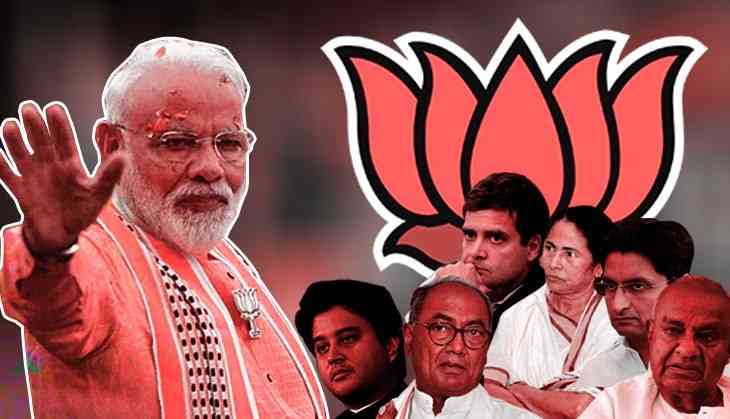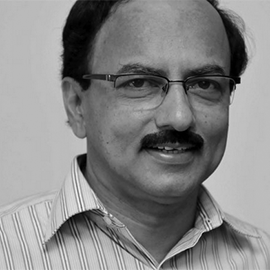Modi, Shah turn all calculations on its head, scale new peaks in 2019 Lok Sabha polls

The story of the second consecutive massive mandate for Narendra Modi is not about equalling Jawaharlal Nehru’s and Indira Gandhi’s records in electoral politics, but effectively demolishing the caste and dynastic hold on the people ever since Independence.
Sailing against considerable odds, the Bharatiya Janata Party led by Prime Minister Narendra Modi has not only increased its tally of seats from 282 to 303 in the Lok Sabha, but it has equalled what monolithic Congress under Nehru could do in 1957 and Indira Gandhi repeated in 1971 of getting a clear majority for one party.
But the proliferation of smaller dynasties and caste-based politics across the country over the last four decades meant the splintering of votes and the emergence of entitlement politics.
In the course of two elections of 2014 and 2019, Narendra Modi has brought about a paradigm shift, which his opponents are struggling to grasp and come to terms with.
The BJP’s performance under Modi-Shah duo having peaked in 2014 in states like Uttar Pradesh, Bihar, Madhya Pradesh, Rajasthan, Gujarat, Maharashtra, Karnataka, Chhattisgarh and Uttarakhand and the Union Territory of Delhi, bringing the party a tally of 218 seats out of 283, the convention wisdom suggested that it was ‘bound’ to lose some seats, if not heavily.
The setback the BJP suffered in the Madhya Pradesh, Rajasthan and Chhattisgarh Assembly polls just a few months before general elections seemed to confirm the possibility.
And the ‘Mahaghabandhan’ forged, specially in Uttar Pradesh and Bihar, suggested that it would be a tall order for BJP to repeat its 2014 performance.
But, the Modi-Shah combine worked systematically – aided by public campaigns which hit all the right buttons – to not only retain the peaks they had already conquered, but identifying the new ‘peaks’ which waited to be scaled.
The BJP’s single-minded mantra to make a dent in West Bengal paid rich dividends as the party was able to increase its tally from two to 18 in the state, taking on a hostile Mamata Banerjee.
In Odisha, the BJP gently captured nine seats out of 21, but Naveen Patnaik retained the chief ministership for the fifth consecutive term.
NEW GAME PLAN
Shiv Sena in Maharashtra and Janata Dal (United) in Bihar which together account for 88 seats, were crucial for the BJP’s game plan to succeed and it went out of the way to keep them in the fold. In Bihar, for instance, though Nitish Kumar’s JD(U) had won only two seats last time, he was given 17 seats to contest, with the BJP sacrificing five seats it had won.
When the results came, the dividends were obvious: In Bihar, the alliance had increased its tally from 31 seats to 39 out of 40 and in Maharashtra, it managed to retain 41 seats it had won in 2014.
In Karnataka, the BJP allowed the Congress-JD (S) alliance to stew in its contradictions and won an unprecedented 25 out of 28 seats, while the Congress registered its worst performance of winning just one seat. Former Prime Minister HD Deve Gowda and former Union ministers Mallikarjun Kharge, Veerappa Moily and KH Muniyappa were among those who had to eat the humble pie.
In Tamil Nadu, however, BJP’s strategy of aligning with the AIADMK backfired, though it was a gamble worth taking.
In Uttar Pradesh, BJP had no choice but to take on the formidable-on-paper alliance of BSP-SP-RSP with the development agenda, relying heavily on some crucial welfare schemes like Jan Dhan, Ujjala, Mudra, Pradhan Mantri Awas Yojana and Ayushman Bharat which it had implemented over the last five years. The party, having set up 160 call centres reached out to 21 crore beneficieries, and promised further sops if the BJP was voted back to power. It apparently worked as the ‘chemistry’ BJP developed trumped the ‘mathematics’ the ghatbandhan had relied on.
The 2019 Lok Sabha elections will also be remembered for the slaying or diminishing of the dynasties which have proliferated around the country.
Despite mounting a massive, aggressive and extremely negative campaign, aided and abetted by a plethora of ‘fake news’, the Congress dynasty came a cropper. Its national tally marginally went up from 44 to 52. Congress president Rahul Gandhi suffered a humiliating defeat at Amethi, but distant Wayanad came to his rescue.
In Karnataka, the JD(S) led by patriarch HD Deve Gowda, is not only facing the prospect of losing the state government in runs in alliance with Congress, but the party itself faces imminent demise.
In Haryana, the Hoodas and the Choutalas have been cut to size while in Madhya Pradesh, Jyotiraditya Scindia has copped first defeat for the Scindia family. In Maharashtra, Sharad Pawar’s NCP is going nowhere.
But, not all dynasts have lost out as Rajashekhar Reddy’s son Jagan Mohan Reddy is on the ascendancy in Andhra Pradesh after a long struggle, while Chandrasekhar Rao in the neighbouring Telangana failed to live upto his ambitions.
In Tamil Nadu, MK Stalin has finally succeeded in inheriting his father M Karunanidhi's legacy, also reviving in the process the political careers of alleged 'scamsters' such as A Raja, Dayanidhi Maran, Kannimozhi and Karti Chidambaram.
Having got a clear-cut majority on its own BJP and Narendra Modi will be able to choose the allies who need to be accommodated in the ministry and also their portfolios.
With the opposition in complete disarray, the Modi government can be expected to quickly unfold its main agenda for the next five years, which will surely keep an eye on securing another term for the party.
First published: 24 May 2019, 16:25 IST

